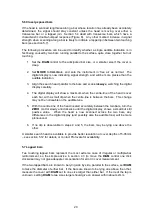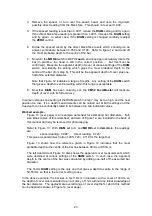
25
Please note that the results of this bar-sizing procedure can be significantly affected by the
presence of neighbouring bars. Before attempting to estimate a bar-size, the location of all
bars should have been mapped out, so that a suitable measurement position can be
selected. If diameter-measurement is attempted in a congested situation, the effect of the
nearby bars is to increase the spaced (white-face) reading, and therefore over-estimate the
spaced-to-direct ratio and the value of the distance-to-centre. During the second stage of
the procedure, the diameter of the bar will be (possibly seriously) over-estimated; but
when half that diameter is subtracted from the distance-to-centre, the deduced
cover
will
usually be only marginally in error.
The table below shows the results of attempting to measure the diameter and cover of the
central one of three parallel bars at various values of pitch between centres. The true
values of size and cover were 16mm and 31mm respectively.
Centres-
Indicated
Indicated
Error in
Error in
-pitch diameter cover diameter cover
150mm
16 to 20
30 to 31
<1 size
1mm
100mm 20mm 31mm 1
size <1mm
75mm 25mm 33mm 2
sizes 2mm
50mm
32 to 40
33 to 34
>3 sizes
<3mm
Note also that the same method can also be used for depths of cover below 30mm. By
appropriate choice of the
DIAM
setting, bars with cover as shallow as 10mm can be
accommodated. For steps 7 and 8, use the white face of the search head if the depth
indicated using the black face is less that 30mm, and subtract the usual 30mm from all
cover readings; or alternatively use additional spacers.
Figure 14 Range of applicable depths for recommended method
of estimating bar size.









































